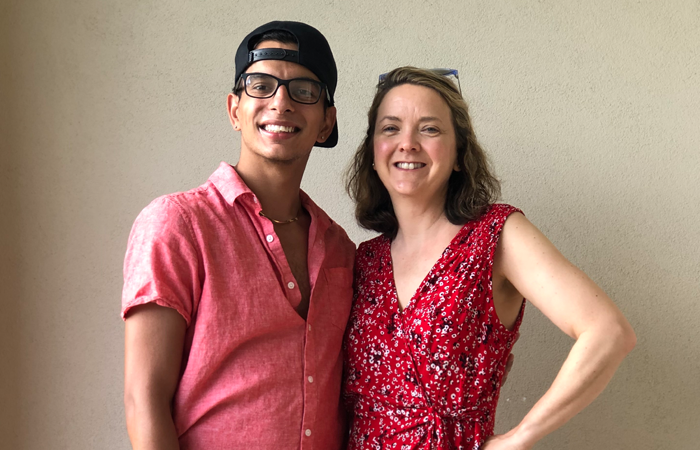Before adopting, Adoptive Families readers uniformly report that their biggest worry is about attaching to their child. Although we may know what research has shown—adoptive families form bonds as successfully and intensely as biological families—many of us worry anyway. What will happen in our family? What if we do something that hampers attachment?
The good news is that bonding emerges naturally through everyday child care. As you feed, rock to sleep, play with, and cuddle your new child, you will become fiercely attached to him, and he to you. Here are expert answers to the most common questions we’ve heard from readers in the early stages of parenthood.
Pre-Parenthood
Should I take a baby-care class? I’m concerned I won’t have anything in common with pregnant moms.
“Absolutely,” says Joni Mantell, director of the Infertility and Adoption Counseling Center, which offers classes several times a year in New York and New Jersey.
The IAC Center’s classes cover child-care basics—feeding, sleeping, and bathing—skipping childbirth and breastfeeding. In addition, “we focus on emotions and etiquette at the hospital when there are two sets of parents involved,” says Mantell. “We discuss everything from birth plans to whether or not to bring a gift (and what kind of gift) to how to deal with the difficult moment of saying goodbye.” In classes geared to international adoptive parents, the focus is on helping a toddler transition.
Mantell urges parents to take a class, even if an adoption-specific class is not an option. “Adoptive parents can be so focused on when (and whether) they will get to parent that they lose sight of preparing. I’ve heard about new adoptive parents putting kids in the car seat facing the wrong way, and so on. Parenting requires some education, and a class also helps to build confidence.” If you’ll be enrolling at a local hospital, Mantell advises pairing up with another pre-adoptive couple, so that you can support each other when faced with “When are you due?” questions.
Feeding
Is it possible to bond without breastfeeding? Should I try breastfeeding?
“Much is made of the benefits of breastfeeding, but you can bond while bottle-feeding just as well. When feeding, snuggle your baby in your arms, make eye contact, and allow skin-to-skin contact,” says Sarah Springer, M.D., a Pittsburgh-based adoption medicine expert. Because feeding is such a powerful bonding tool, “Children adopted as older infants or toddlers may also benefit from taking bottles, even after they’re old enough to be using a cup exclusively.”
Breastfeeding is an option for moms adopting newborns, though it takes a lot of work and patience, with unpredictable results. It is possible to induce lactation through frequent pumping, and with medications or supplements, though many women find they need to provide additional formula through a supplemental nursing system.
Our pediatrician says we should stop bottle-feeding now that our son has turned one. Do we have to?
If your child received inadequate nutrition before coming home, he may need the extra calories and nutrients that formula can provide beyond age one. For other kids, “The bottle is really a bonding tool, not a feeding tool. Many toddlers who barely slow down for a hug will relax and enjoy taking a bottle in a parent’s arms,” says Springer. Florida-based Yoli Collazo bottle-fed her two-year-old daughter when she first came home from China. “It helped immensely in the bonding process, as I fed her and looked into her eyes,” she says.
“In most orphanages, children aren’t fed in someone’s arms,” says Deborah Borchers, M.D., an expert in adoption medicine, based in Ohio. “So give your child that experience. Provide warmth and comfort while feeding, not just nutrition. For a newly adopted toddler, you don’t want to be encouraging feelings of independence.”
Some don’ts for extended bottle-feeding: Don’t let your child walk around with a bottle, and never let him take a bottle to bed, as this can lead to tooth decay. If your child’s nutrition is on track, you may offer another liquid in the bottle, like whole milk, but never give juice in a bottle.
Do I put my baby on a feeding schedule, or do I let him eat on demand?
“We’ve learned that the best way to teach children healthy eating habits is to let them eat when they’re hungry and stop when they’re full. A clock (or a parent watching one) doesn’t know that—the baby does,” says Springer. “When a newborn’s hungry, he will suck on his fingers or root (move his lips in a smacking motion toward anything that touches his cheek). Older infants develop specific cries to indicate hunger, and later gesture or use words.” Some formula-fed babies quickly settle into a routine, eating about every four hours. Others never do.
Feeding on demand will help strengthen your bond. “Babies who learn to count on their parents to quickly meet their needs develop strong attachments. A baby who is left crying, because the clock says it’s not yet time to eat, may become more anxious,” says Springer.
Flexibility is the name of the game, but having a routine—as opposed to a schedule—can be reassuring to baby. Devise a cycle of events—playtime, feeding, nap time—but don’t pin specific activities to set hours of the day. For newborns, feedings can last an hour or more, so find a comfortable spot, like a sofa or rocking chair, where you’ll sit for most feeds.
How much should I let my newly adopted toddler eat? He wants to eat constantly and consumes enormous amounts. Should I let him?
“Children who have experienced hunger learn the adaptive strategy of eating as much as possible whenever they can,” says Springer. Alarmed by the amount that these children eat, parents are understandably inclined to limit feedings. This only reinforces the adaptive strategy. Instead, Springer says, parents should allow unlimited access to healthy, age-appropriate foods. “Once your child learns that she can always have as much as she needs, and that her tummy doesn’t feel so good when she eats too much, she’ll slow down and eat more reasonable amounts within a few months.”
Sleep
At what age will a baby start sleeping through the night?
Newborns wake several times a night, wanting comfort and a bottle. With healthy sleep habits, by four to six months old, babies can generally sleep eight to 12 hours a night, Springer says. “Nighttime feeds should be different from daytime—no lights, no playing, all business, then back to bed.”
It’s a different story for kids adopted at older ages, particularly if they’ve experienced trauma, neglect, or institutional care, says Springer. “Bedtime may have been scary, lonely, or uncomfortable. Parents may need to reassure the child that the new sleeping arrangement is safe, and that they’re there if the child needs them—a fact that won’t be taken for granted by a child who’s never experienced that before.
Our baby still wakes several times a night. My mom told me to let her “cry it out”—should we do this?
The theory of “sleep training”—letting a baby cry for gradually longer periods before you offer comfort, with the goal of “training” him to put himself back to sleep—may sound tempting. But adoption experts agree that this approach isn’t right for our kids.
“That kind of parenting is not appropriate for adoptive kids because it creates a distance between parent and child,” says Bill Sears, M.D., parenting expert, adoptive father, and the man behind attachment parenting theory.
“‘Cry-it-out’ doesn’t reinforce a parent’s presence, but, rather, reminds the child of his previous negative bedtime experiences,” says Springer. She recommends that a parent start sleeping in the new child’s room (or wherever you want your child to sleep long-term), and gradually wean yourself out of bedtime as the child settles in.
Should we let our child sleep in our bed? If so, for how long?
Sears recommends sleeping near your child, using a co-sleeper that attaches to the side of your bed (like the convertible bassinets you can buy on armsreach.com). He says, “The baby’s close to you, within comforting distance, but not in your bed.”
Borchers adds, “There are two people you have to take care of with sleep: the child and yourself. Making sure the child doesn’t feel abandoned is key, even if this means that your child sleeps with you, or you sleep in his room. But because you also matter, I’ve worked with parents who take turns sleeping in a spare bedroom, so that each gets a full night’s sleep, every other night.”
As for the worry that your child will never leave your bed? “Babies who sleep close to parents develop such a sense of security that they will eventually go into their own beds and sleep better,” says Sears.
My toddler cries every night and is terrified to be away from me. My family tells me this is not normal. How should I handle this?
Stacy Clark’s daughter, Hanna, cried night after night, exhausting her parents and disrupting life for their older child. But because their new baby was 10 months old, “our family and friends seemed to expect us to be up to speed and back to normal right away,” says Clark. “Maybe I expected the same, since I didn’t ask anyone for help.”
“My three-year-old still does not sleep through the night,” says Michele Curay-Cramer, mom of Elias. “I’m almost embarrassed to admit that, because I’m sure, in everyone else’s eyes, we’ve done something wrong.”
For children adopted at older ages, Borchers reminds parents to stay flexible, to keep the child’s need for security in mind, and to trust their instincts. “People who haven’t adopted do not understand what is going on. When you adopt, the child’s emotional state reverts to birth,” she explained. “No parent in her right mind would bring home a child from the hospital and let her cry it out. You get in there and respond, and you let her know you’re taking care of her.”
Sears concurs. “If you hear your child cry in the middle of the night, take a deep breath, count to five, ask yourself, ‘If I were my baby, how would I want my mother to react?’ and do that. You almost always get it right.”
Extended Family and Beyond
When should we allow people to visit our newly adopted infant?
Whether you adopt a newborn or an older baby, you may want to “cocoon” for the first few weeks, to jump-start bonding, free of distractions. You may even unplug your phone (or turn off your cell phone). After you start allowing visitors to meet your little one, do what you can to keep your family circle small for that first year—become homebodies as you get to know each other better.
“Shrink your world, so that your child understands that her family and her parents can be trusted and relied upon,” advises Tracy Whitney, who brought her daughter home to Pennsylvania at 14 months. “Be super-intentional about it, to the point of giving up outside activities that might interfere with that purpose. You won’t be sorry!”
I have to go back to work. Will this affect our fledgling attachment?
“First, plan as much time off as possible, without going broke or losing your job. Start visiting with the child-care provider seven to 10 days before returning to work, spending time there together at first, then leaving the child for gradually increasing periods of time. Leave him with pictures and security objects from home, like a blanket or stuffed animal. Plan for a consistent caregiver to meet the child in the morning, and don’t sneak out—doing so may seem easier, but this will leave your child feeling anxious,” says Springer. “Plan downtime once you’re home, to re-establish the connection. Your first months together are a great time to rely on frozen dinners, and to skip meetings, volunteer work, and most social events.”
Attachment Parenting
What is attachment parenting? Should we pursue it?
When you’ve waited forever for your child to come home, you don’t need to be told to keep the baby close to you, respond to all her needs on demand, and shower affection on her little, perfect form. But there is an expert-advocated and parent-tested theory behind this method, called attachment parenting. The idea is that parents who are emotionally and physically available to their children help them to feel secure and form a healthy bond.
Sears reassures parents that they can bond with a child at any age. “But if you adopt an older baby, or a toddler who has not had a lot of connection, a lot of time in caregivers’ arms, then you’ve got some catch-up bonding to do. Pretend your toddler is a newborn. Hold her on your lap, massage her. Play together in the park. Woo her with touch and eye contact. Eventually, she’ll think, ‘OK, these are special people, I like being here.’”
Baby-wearing is a wonderful way to keep baby close (and your hands free). Most slings and carriers fit infants from birth up, and some, like the ERGObaby Carrier, can accommodate toddlers up to 40 pounds.
Our baby’s finally home—and I feel detached and exhausted. Is this normal?
If the mystical bond you keep hearing about seems to elude you at first, you’re not alone. Maria Haagensen, mom to 18-month-old Esther, was surprised to feel so ambivalent about the huge change that had just occurred. “It was weird that the years of waiting were suddenly over. I felt like a part of me had been lost in some way, and I gained a new side—mother, a role I had wanted but did not know what to do with, now that it was here,” she says.
Sometimes one parent bonds much more quickly than the other. “I was surprised to be the one who did not bond right away to the baby,” says Collazo. “A lot of guilty feelings arose from that situation, but I took it one day at a time, and I never stopped faking it until I felt it. It was not long before I could not live without my daughter.”
Once you’re back home, try to connect with a support group, lean on your partner, and take care of your own health. If feelings of detachment persist, or start to worsen, seek help. About 10 percent of new adoptive parents experience post-adoption depression, and as many as 65 percent have some feelings of depression.
The baby refuses to be held by my husband, and screams when I’m out of sight. What should I do?
“It’s quite normal for a baby to attach primarily to his mother in the first year or two,” says Sears. But generally, babies learn that Mom is for feeding and Daddy is for fun. You can run with these roles and let Dad have lots of playtime with baby. Sears also recommends baby-wearing—this “lets baby get comfortable with Dad’s movements.” Diana Schwab, psychotherapist and developmental specialist with International Adoption Health Services of Western Pennsylvania, suggests:
- Let Dad and baby play games, like peek-a-boo, or have some (safe) rough-house play, with lots of giggles and close moments.
- If baby is an easy feeder, Dad should be the feeding person.
- Sit on the couch and put a favorite toy on the other side of Dad. Encourage baby to crawl over Dad to reach the toy.
- Play lots of games involving both parents, so baby doesn’t feel he “loses” Mom when he’s with Dad.
Why is parenting so much harder than I expected? Can I really do this?
Insecurity seems to be as much a part of parenting as dirty diapers. After all the anticipation, dealing with the reality of having an infant or a toddler at home can be surprisingly difficult.
In almost all cases, contact and time will work their magic. You have to trust the process, says Clark. “Bonding with a baby or toddler can be like that saying, ‘a watched pot never boils,’” she says. “If you worry too much about bonding, you might miss the moments when you truly connect with your little one.”
Hang in there. Sooner or later, every experience will not be a new one, and you and your baby will get used to the idea of each other. The moments will come when your baby clings to you at the approach of a stranger, quiets down as soon as you go to her at night, looks for you for comfort when he falls down, or lights up every time you enter the room. You’ll realize that you’ve done it—you’re a parent!—and that things are going to be just fine.
Compiled by the editors of Adoptive Families, with writing and reporting contributed by COLLEEN CALVANI.


